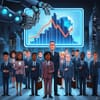The impact of artificial intelligence on the job market is a pressing concern, with experts warning of significant job displacement. According to recent studies, AI could eliminate 20-30 million US jobs by 2035, disproportionately affecting certain sectors. Administrative support, customer service, fast food, and transportation are among the industries most at risk.
In the manufacturing sector, over 510,000 US jobs were automated in 2025 alone, while retail saw 310,000 roles affected in the same year. The financial sector is also vulnerable, with 92,000 jobs linked to AI-based fraud detection and risk analysis tools. Transportation and warehousing have seen 230,000 eliminated positions, with a 21% automation rate.
Globally, the picture is equally dire. Fourteen million jobs worldwide have already been lost directly due to AI-driven technologies, and 800 million people could lose their positions by 2030. While AI may create new jobs, the net loss is expected to be significant, with 83 million jobs lost and 69 million created by 2027.
The economic consequences of this shift will be far-reaching. The top 10% of Americans are expected to capture $180 trillion in new AI-driven wealth, widening the inequality gap. The bottom 90% of the population may experience a 1% annual wealth shrinkage over the next decade. Regional GDP growth could also be reduced by 0.8% annually due to AI-induced unemployment.
To mitigate these effects, governments and companies are investing in reskilling programs and AI-related workforce transitions. The US Department of Labor allocated $1.3 billion for workforce reskilling focused on AI-displaced workers. While AI may pose significant challenges, it also presents opportunities for growth and innovation. The key will be to navigate this transition carefully and ensure that the benefits of AI are shared by all.


